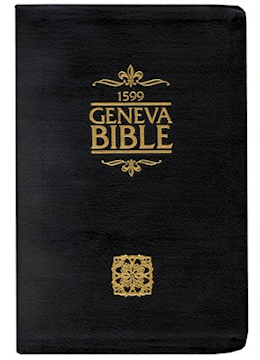Textus Receptus Bibles
Geneva Bible 1560/1599
| 13:1 | And I saw a beast rise out of the sea, hauing seuen heads, and ten hornes, and vpon his hornes were ten crownes, and vpon his heads the name of blasphemie. |
| 13:2 | And the beast which I sawe, was like a Leopard, and his feete like a beares, and his mouth as the mouth of a lion: and the dragon gaue him his power and his throne, and great authoritie. |
| 13:3 | And I sawe one of his heads as it were wounded to death, but his deadly wound was healed, and all the world wondred and folowed the beast. |
| 13:4 | And they worshipped the dragon which gaue power vnto the beast, and they worshipped the beast, saying, Who is like vnto the beast! who is able to warre with him! |
| 13:5 | And there was giuen vnto him a mouth, that spake great things and blasphemies, and power was giuen vnto him, to doe two and fourtie moneths. |
| 13:6 | And he opened his mouth vnto blasphemie against God, to blaspheme his Name, and his tabernacle, and them that dwell in heauen. |
| 13:7 | And it was giuen vnto him to make warre with the Saints, and to ouercome them, and power was giuen him ouer euery kinred, and tongue, and nation. |
| 13:8 | Therefore all that dwell vpon the earth, shall worship him, whose names are not written in the booke of life of that Lambe, which was slaine from the beginning of the world. |
| 13:9 | If any man haue an eare, let him heare. |
| 13:10 | If any leade into captiuitie, hee shall go into captiuitie: if any kill with a sword, he must be killed by a sword: here is the patience and the faith of the Saints. |
| 13:11 | And I beheld another beast comming vp out of the earth, which had two hornes like the Lambe, but he spake like the dragon. |
| 13:12 | And he did all that the first beast could doe before him, and he caused the earth, and them which dwell therein, to worship the first beast, whose deadly wound was healed. |
| 13:13 | And he did great wonders, so that hee made fire to come downe from heauen on the earth, in the sight of men, |
| 13:14 | And deceiued them that dwell on the earth by the signes, which were permitted to him to doe in the sight of the beast, saying to them that dwell on the earth, that they should make the image of the beast, which had the wound of a sword, and did liue. |
| 13:15 | And it was permitted to him to giue a spirit vnto the image of the beast, so that the image of the beast should speake, and should cause that as many as would not worship the image of the beast, should be killed. |
| 13:16 | And he made all, both small and great, rich and poore, free and bond, to receiue a marke in their right hand or in their foreheads, |
| 13:17 | And that no man might buy or sell, saue hee that had the marke, or the name of the beast, or the number of his name. |
| 13:18 | Here is wisdome. Let him that hath wit, count the number of the beast: for it is the number of a man, and his number is sixe hundreth threescore and sixe. |

Geneva Bible 1560/1599
The Geneva Bible is one of the most influential and historically significant translations of the Bible into English, preceding the King James translation by 51 years. It was the primary Bible of 16th century Protestantism and was the Bible used by William Shakespeare, Oliver Cromwell, John Knox, John Donne, and John Bunyan. The language of the Geneva Bible was more forceful and vigorous and because of this, most readers strongly preferred this version at the time.
The Geneva Bible was produced by a group of English scholars who, fleeing from the reign of Queen Mary, had found refuge in Switzerland. During the reign of Queen Mary, no Bibles were printed in England, the English Bible was no longer used in churches and English Bibles already in churches were removed and burned. Mary was determined to return Britain to Roman Catholicism.
The first English Protestant to die during Mary's turbulent reign was John Rogers in 1555, who had been the editor of the Matthews Bible. At this time, hundreds of Protestants left England and headed for Geneva, a city which under the leadership of Calvin, had become the intellectual and spiritual capital of European Protestants.
One of these exiles was William Whittingham, a fellow of Christ Church at Oxford University, who had been a diplomat, a courtier, was much traveled and skilled in many languages including Greek and Hebrew. He eventually succeeded John Knox as the minister of the English congregation in Geneva. Whittingham went on to publish the 1560 Geneva Bible.
This version is significant because, it came with a variety of scriptural study guides and aids, which included verse citations that allow the reader to cross-reference one verse with numerous relevant verses in the rest of the Bible, introductions to each book of the Bible that acted to summarize all of the material that each book would cover, maps, tables, woodcut illustrations, indices, as well as other included features, all of which would eventually lead to the reputation of the Geneva Bible as history's very first study Bible.